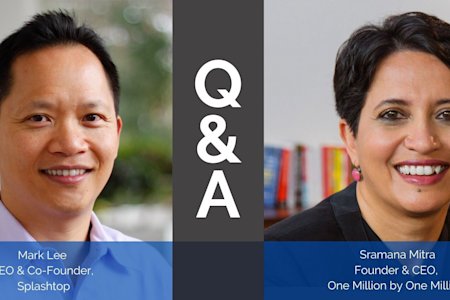Splashtop's CEO and Chief Evangelist Mark Lee, joins Sramana Mitra, Founder and CEO of One Million by One Million (1Mby1M), for a Q&A on Splashtop's history and cybersecurity. Copied below are a few highlights of the interview by Sramana Mitra on her blog.
Sramana Mitra: Tell me about what you are doing and tell me about Splashtop?
Mark Lee: Splashtop is my second startup. The first one and this current one were founded with three other MIT friends: Robert Ha, Thomas Deng, and Philip Sheu. They are three MIT buddies of mine.
We have known each other for 30 years.
When my 3 co-founders and I started in 2006, the company was called DeviceVM.
We pivoted in 2011 to become Splashtop. We have been bootstrapping. All of the funding in the first four to five years into the prior business – the DeviceVM business.
We then changed our business to browser OS. We predicted that Chrome Book and Chrome OS will be big and were the first to build a browser OS for PC OEMs. That was the initial business for the company. We changed our business to remote access and remote support around 2010.
Since then, we have bootstrapped the company to where we are today. We just announced our unicorn round in January. It has been a long journey for us with lots of ups and downs. All four of us are still together as great friends and co-founders.
Sramana Mitra: That’s great. Congratulations. Tell me a bit about why the customers are using your products. What problems are you solving?
Mark Lee: Our main theme is remote work, remote learning, and remote support. I would say that those are the three primary use cases. Most of our focus has been on the SMB market.
When people are locked down, they need access to their office computers. We are in many offices and clinics of doctors, dentists, and accountants. For example, accountants need remote access to their QuickBooks. All of them are using our product to enable remote work.
COVID has also accelerated our growth. Our business grew 170% last year.
In remote learning particularly, over 250 colleges and K-12 schools, MIT, Harvard, Stanford, UCLA, USC, and other community colleges have become our customers in the past seven months. They all have physical labs, and they need to enable students to be able to access these lab computers running specialized software like Adobe, AutoCAD, and so forth.
There is remote support too. When the employees are all at home, IT needs to be able to remote support all these employees that are working. It is the same with teachers, they are at home and they might run into some issues.
School IT also needs to be able to operate remotely. There are all these schools and student devices that need help in troubleshooting as needed. We have seen all three markets take off.
Sramana Mitra: What does the competitive landscape look like for what you offer?
Mark Lee: Pre-COVID, we primarily competed with LogMeIn and TeamViewer in the marketplace. We have been successful in replacing them in the past several years because our products have higher performance and they are easier to use.
Our products are faster, better, and more cost-effective. We are also easy to do business with and we provide very strong customer support. Our 97 overall user rating from Capterra third-party reviewers is much higher than our competitors' ratings. People love our product.
That is why half of the people who try our product end up buying. It is also a self-service approach. During COVID, everything accelerated, but at the same time, we found that a lot of businesses are embracing our solution to replace or bypass their VPN.
Traditionally, most businesses have been using VPN and RDP. VPN gives too many privileges to the end-user from home. Once you are connected to VPN, there is a lot of potential lateral movement from your home devices which could be infected with malware that will go across the corporate network.
Also, the performance is a big issue with VPN. Imagine that you are connected with a VPN and all of your home traffic is routing to your corporate network. Let’s say we are doing a Zoom meeting. All the video traffic is routing to your corporate network before it goes out to the internet.
It’s a big problem and a big challenge for corporate networks to be able to support so many people on Zoom calls. With Splashtop, your Zoom, Salesforce, and all the other sessions are not routed to your corporate network like a VPN would do. You are just launching the application on your home computer. It’s only when you are accessing corporate assets that you will be using Splashtop applications dedicated for that traffic. It makes it much easier for IT to monitor and secure the entire environment.
Still, I wouldn’t say that we are ripping and replacing the VPN because VPN still has its value for many other usages. However, VPN was never designed for remote access. It doesn’t scale well and has a lot of security challenges. The market is moving towards a different view of trust, a different ecosystem solution to address the shortcoming of today’s VPN solutions.
Read the full Q&A on the One Million by One Million Blog here.




